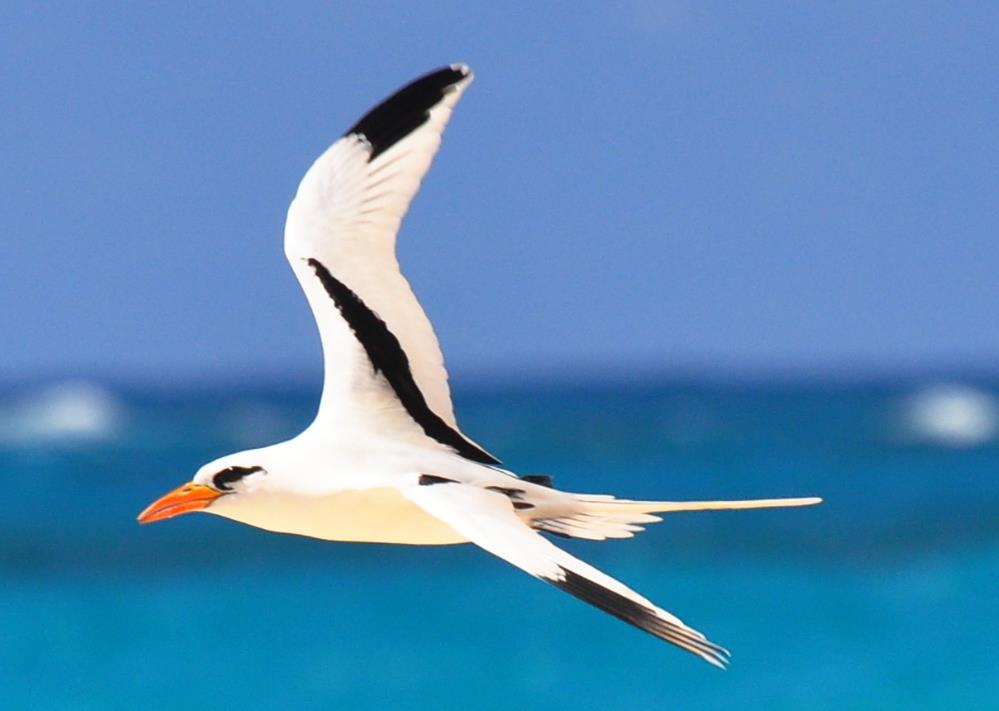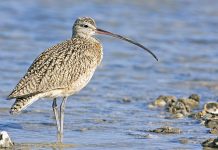The white-tailed tropicbird (Phaethon lepturus) is the smallest of the tropicbirds.
Behavior and Habitat: It is much more agile in flight than its red-tailed relation, and its tail-streamers are more pliable. It plunge-dives for fish and squid on the open tropical and subtropical seas like the Red-tailed but, perhaps because of its smaller bulk, it rarely takes prey much below the surface of the water. Air cells under the skin of the fore-body cushion the impact of the dives.
On their breeding islands (all outside Australia) the white-tailed tropicbirds nest about every 9-10 months. As a result of this cycle, some birds can be found breeding every month. They fight for nest sites, struggling in silence with interlocked bills, and court in brilliant aerial displays. However small tight groups of up to ten circles, weave above their breeding grounds, uttering a repetitive rattling, and drooping and undulating their tails. Often pairs break off, go into glides, and zigzag about, one bird above the other, the top bird’s wings swept down to the raised wings of the bird below. Then they swoop back to their nests to copulate.
Nest sites may be concealed in rocky holes, crevices, scrapes under overhangs, or, on Christmas Island, even a tree fork or tree hollow. No attempt is made to line it. The parents brood their single downy chick for only a few days but return daily to feed it for a couple of months before it is ready to fledge. When left alone by day, it may be killed by other adults seeking a nest hole. Upon fledging, after 12-15 weeks, young birds fly straight out to sea unaided, where they wander around the tropics, returning only when they are ready to breed. White-tailed Tropicbirds are nomadic and probably visit Australia, particularly the northeastern coast, regularly. Most of white-tailed tropicbird seen off the western and eastern coasts have been juveniles – identifiable by black bars on upperparts and lack of tail-streamers – and were probably blown there by cyclones.

Identification: Both adults are similar. The body is generally white with a black crescentic stripe through the eye. A black line from upper wing to inner secondaries and scapulars, and on outer flight feathers. Two long white or yellow central tail feathers with black shafts. Thighs streaked black. Some birds seen off northwestern Australia have a golden yellow sheen on their body plumage. The eyes are dark brown. The bill is greenish yellow to orange. Feet and soles are white tinged with blue; toes, including webs, are black. The immature bird has thin black bars on the upper parts; and no tail-streamers. The downy young is a silky grey fawn from hatching; bill and feet black.
Vocalizations: White-tailed Tropicbird voice rattling t-t-t-t and tick calls in courtship flight. Loud, defensive screaming at the nest.
Nesting: The nesting breeds occur throughout the year. Nest in a tree fork or hollow; a scrape in hole or crevice in rock face, sometimes tree fork or hollow on Indo-Paczfic islands; no nesting material gathered.
Eggs and incubation: The bird lays one egg; white, with many dark purple-brown spots; rounded- or oblong-oval, about 50 x 36 mm. The incubation period is about 40-41 days, for both sexes. Young fledge in 12-15 weeks.
Distribution: The White-tailed Tropicbird is found in tropical and subtropical seas around the world. Visits waters off northwestern and northeastern Australia but does not breed in the region; occasionally blown inshore in the southeast by storms.
Alternative Names: This bird is known as the Golden Bosun-bird and Yellow-billed Tropicbird.
Size: The bird size is about 400 mm, excluding 300 mm tail-streamers and the wingspan is 89–96 cm.
Races: There are about five races; three in Australia: one white from Cocos Keeling Islands and another golden tone from Christmas Island wanders to the northwest coast. The third is the white race wanders to the northeast coast from its breeding grounds in the central Pacific between Micronesia, New Caledonia, Polynesia, and the Hawaiian islands.
Read More: Red-tailed Tropicbird: A Stunning Marvel of the Skies







